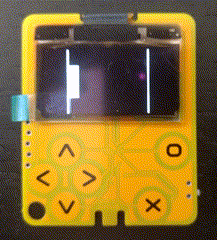At the heart of every PewPew device is the pew Python library, which gives you access to the 8x8 screen and buttons. That library is different on different devices, but gives your code a consistent interface, so that a PewPew game written on one device will work on any other. I already had a version of the pew library for the SH1106 OLED screen, but it was written before displaio had support for those screens, and just talks to the screen directly over SPI.
This time I wanted to use the higher-level capabilities of displayio — mostly because then when your program raises an exception, you can see it on the screen and read the error without having to use the serial connection. Unfortunately, doing it the naive way, by using TileGrid, would be too slow. So I went for a kind of compromise — I still generate the data to be sent to the display myself, but then I use the FourWire bus object on the board.DISPLAY to send that data to the display:
def show(pix):
pix_buffer = pix.buffer
bus = board.DISPLAY.bus
for y in range(8):
pix_index = pix.width * y
index = 0
board.DISPLAY.bus.send(0x0a, b'')
board.DISPLAY.bus.send(0x11, b'')
for x in range(8):
bus.send(0xb0|y, _PATTERNS[pix_buffer[pix_index]])
index += 10
pix_index += 1The 0x0a and 0x11 commands send the column to 24 (to center the image), and the 0xb0|y command sets the row to the value of y. Then I just keep sending the pre-defined pattern data for the current pixel, in chunks of 10 bytes. Simple yet effective.

Of course now all the PewPew games will work on this device.
 deʃhipu
deʃhipu
Discussions
Become a Hackaday.io Member
Create an account to leave a comment. Already have an account? Log In.